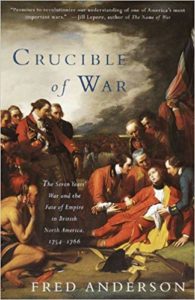 Fred Anderson has written as good a history of the Seven Years’ War in North America, commonly called the French and Indian War, as one can find. At some 835 pages excluding the index, it is not, however, for the light reader.
Fred Anderson has written as good a history of the Seven Years’ War in North America, commonly called the French and Indian War, as one can find. At some 835 pages excluding the index, it is not, however, for the light reader.
Much of the previously published work on this extended conflict has focused on the relationship between this war and the one that followed a dozen years later, the American War for Independence. For Anderson, however, the struggle between Great Britain and France in North America can be studied as an event worthy of examination in its own right–regardless of what came after. His evaluation of the Seven Years’ War as the greatest conflict of the eighteenth century is fairly well justified.
The book brings to mind a quote from a fine historian, Theodore Ropp, who said, “You choose the ending of a story as you select that story’s beginning.” Anderson’s observation is that many who describe the American Revolution begin the tale at the end of the Seven Years’ War, in 1763. He states that the more fruitful start date should be 1754, when relations between the American colonists and the British government were still relatively amicable. The seeds of revolt were sown during the Seven Years’ War, hence its vital importance to the American nation.
Knopf has done its usual magic, providing a handsome, well-illustrated book that contains excellent maps. The author has included a section of contemporary drawings and artwork with American landscapes that serves to give the reader an idea of how North America appeared, or was perceived to appear, to the participants in the war.
Battles and campaigns are well explained by Anderson but not at the expense of political decision making and diplomacy. The author, who is a professor of history at the University of Colorado at Boulder, provides his readers with descriptions of cultural and personal characteristics that had an impact on the outcome of the war as well.
Finally, Anderson extends the book’s reach beyond war’s end to picture and evaluate the aftermath of the conflict including the Stamp Act, the Quartering Act, and Indian troubles. That allows him to discuss some of the more contentious issues between Americans and London as well as depict how militarily overextended Britain had become in gaining the vast territories she had won during the war.
This is a fine book, one likely to become the definitive history of the North American theater during the Seven Years’ War.




